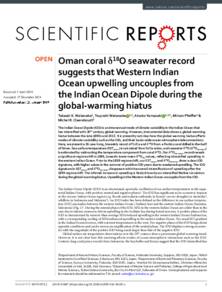Document
Oman coral δ18O seawater record suggests that Western Indian Ocean upwelling uncouples from the Indian Ocean Dipole during the global-warming hiatus.
Identifier
DOI: 10.1038/s41598-018-38429-y
Source
Scientific Reports. v. 9, 1, 1887
Contributors
Watanabe, Tsuyoshi., Author
Yamazaki , Atsuko., Author
Pfeifer, Miriam., Author
Claereboudt, Michel R., Author
Country
United Kingdom.
City
London
Publisher
Nature Publishing Group.
Gregorian
2019-12-01
Language
English
English abstract
The Indian Ocean Dipole (IOD) is an interannual mode of climate variability in the Indian Ocean that has intensified with 20 th century global-warming. However, instrumental data shows a global-warming hiatus between the late-1990s and 2015. It is presently not clear how the global-warming hiatus affects modes of climate variability such as the IOD, and their basin-wide ocean-atmosphere teleconnections. Here, we present a 26-year long, biweekly record of Sr/Ca and δ 18 O from a Porites coral drilled in the Gulf of Oman. Sea surface temperature (SST anom ) is calculated from Sr/Ca ratios, and seawater δ 18 O (δ 18 O sw-anom ) is estimated by subtracting the temperature component from coral δ 18 O. Our δ 18 O sw-anom record reveals a significant regime shift in 1999, towards lower mean δ 18 O sw values, reflecting intensified upwelling in the western Indian Ocean. Prior to the 1999 regime shift, our SST anom and δ 18 O sw-anom show a clear IOD signature, with higher values in the summer of positive-IOD years due to weakened upwelling. The IOD signature in SST anom and δ 18 O sw-anom disappears with the overall intensification of upwelling after the 1999 regime shift. The inferred increase in upwelling is likely driven by an intensified Walker circulation during the global-warming hiatus. Upwelling in the Western Indian Ocean uncouples from the IOD.
ISSN
2045-2322
Resource URL
Category
Journal articles

